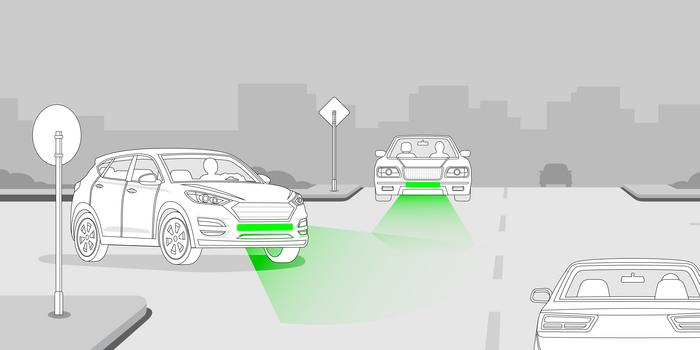The concept of a front brake light has been floating around the automotive industry for some time now. However, no vehicle manufacturer has yet embraced the idea and turned it into a reality on the roads. Recently, a research team led by Ernst Tomasch from the Institute of Vehicle Safety at Graz University of Technology (TU Graz), in collaboration with the Bonn Institute for Legal and Traffic Psychology (BIRVp), has provided compelling evidence to support the implementation of this innovative idea. Their groundbreaking work examined the impact of front brake lights on enhancing road safety through an extensive accident reconstruction study.
This comprehensive analysis involved data from 200 actual accidents occurring at road junctions. The findings suggest that depending on drivers’ reaction times, the introduction of an additional brake light on the front of vehicles could avert between 7.5 to 17 percent of potential collisions. Moreover, in some instances, these front brake lights could reduce the intensity of impacts, thereby diminishing the risk of severe injuries sustained during accidents. The study’s illuminating results have been published in the esteemed scientific journal, Vehicles, making it a pivotal piece of research in the field of automotive safety.
The notion behind front brake lights is deceptively simple. By signaling to oncoming traffic and vehicles approaching from the side, a front brake light provides an essential visual cue that a car is slowing down or preparing to stop. When the light is extinguished, it indicates that a stationary vehicle might initiate movement. According to Tomasch, this visual feedback can significantly truncate the reaction time for other road users, leading to shorter stopping distances and consequently diminishing the likelihood of accidents.
While the theoretical benefits of front brake lights are clear, implementing this technology in real-world scenarios has posed challenges. Previous trials implementing front brake lights as part of practical tests in Slovakia were limited in scope. Hence, the researchers relied on a combination of meticulous accident reconstruction and computer simulations to evaluate the potential efficacy of front brake lights. The investigative team utilized a comprehensive database of car accidents recorded in Austria’s Central Database for In-Depth Accident Study (CEDATU) to reconstruct the sequence of events in those crashes accurately.
Through their simulation experiments, the researchers posited that if vehicles on subordinate roads were equipped with front brake lights, they would likely respond faster in real-world situations. The simulations indicated that the visibility of these front indicators would lead to quicker reaction times and thus a reduction in necessary stopping distances. By comparing real accidents to those recreated in simulations, the researchers were able to ascertain the potential accident-prevention benefits of integrating front brake lights into vehicles.
Despite the undoubtable advantages of front brake lights, the researchers pointed out a crucial factor – visibility. The effectiveness of front brake lights hinges on their ability to be seen by other road users. During their analysis, they discovered that approximately one-third of the reconstructed accident cases revealed unfavorable angles between the vehicles involved, rendering the front brake lights unnoticeable. This raised an important concern about the overall efficacy of front brake lights if not universally visible to drivers.
To address this issue, the research team proposed that vehicles could also be fitted with side brake lights. By illuminating both the front and sides of a vehicle, the likelihood of visibility would significantly increase, enhancing the overall safety benefits associated with these lights. Further investigation into the potential additional effects of side-mounted lights could ultimately lead to more substantial improvements in road safety.
The innovative design of front brake lights adds another layer of practicality. These lights would emit a green glow rather than the traditional red, easily integrating into current vehicle frameworks without extensive modifications. This feature enables retrofitting of existing vehicles at a relatively low cost, making it a practical recommendation for manufacturers and consumers alike.
As the automotive industry becomes increasingly focused on enhancing safety features, the research undertaken by TU Graz and BIRVp represents a crucial step toward addressing prevalent road safety issues. By minimizing human error through visual signals and improving reaction times, front brake lights are poised to play an instrumental role in the future of vehicle design and accident prevention.
The incorporation of front brake lights signifies an opportunity for the automotive industry to rethink traditional design elements by introducing safety innovations. As traffic volumes rise and the risk of accidents escalates, the call for enhanced safety measures becomes more pressing. This investigation into front brake lights provides a compelling argument for their necessity in modern vehicle architecture and establishes a framework for future research.
In conclusion, the study conducted by the research teams from Graz University of Technology and Bonn Institute for Legal and Traffic Psychology has substantial implications for road safety. Although the road to widespread implementation may still be long, their findings lay a solid foundation for further exploration and validation. Automakers must heed these results and consider the potential benefits of adopting front brake lights as a viable solution to reduce accidents and enhance overall road safety.
With increasing collaboration between researchers and manufacturers, and ongoing research initiatives in vehicular safety, the idea of front brake lights may very well transform the landscape of automotive safety in the near future. As we push towards a more automated and safer vehicle environment, innovations such as these will undoubtedly play a pivotal role in shaping the future of transportation.
Subject of Research: N/A
Article Title: N/A
News Publication Date: N/A
Web References: N/A
References: N/A
Image Credits: N/A
Keywords
vehicle safety, front brake lights, accident prevention, automotive design, reaction time, traffic psychology, road accidents, vehicle technology, Graz University of Technology, Bonn Institute for Legal and Traffic Psychology




